Accurate Extraction Method for Continental Margin FOS Line Considering Terrain Continuity
Abstract
1. Introduction
2. Automatic Identification of Negative Topographic Feature Lines Based on Rolling Ball Transformation
2.1. Basic Principle of the Algorithm
2.1.1. Terrain Identification Using Rolling Ball Transformation and Extraction of Negative Topographic Feature Lines
2.1.2. Principle of Extracting Negative Topographic Feature Lines Based on Spatial-Scale Thresholds
2.2. Analysis of Algorithm Limitations
3. Precise Extraction of Continental Margin FOS Line Considering Topographic Continuity
3.1. Importance Ranking of Negative Topographic Feature Lines
3.2. Multi-Criteria Continental Margin FOS Line Filtering Process
3.2.1. Slope Method
3.2.2. Water Depth Method
3.2.3. Denoising Method
4. Experimental Validation and Analysis
4.1. Visual Interpretation Evaluation
- When the screening threshold is r = 0, the extracted negative topographic feature lines are widely distributed in areas of the seafloor with significant slope changes and complex triangular-mesh structures. Each feature line segment is essentially located in the downslope breakline region of the local terrain and exhibits concave features. This demonstrates that the proposed method can effectively distinguish negative terrain areas, and the extracted negative topographic feature lines conform to the basic morphological characteristics of the continental margin FOS line.
- As the importance ranking screening threshold increases, the number of negative topographic feature lines gradually decreases. The retained lines have higher importance ranks, with a greater proportion of points corresponding to the maximum local slope changes. This better aligns with the characteristics of the continental margin FOS line.
- As the screening threshold increases from 0.72 to 0.8, although the extracted negative topographic feature lines exhibit greater local slope changes, they become scattered, short, and detached from the base of the continental slope. Hence, they do not meet the candidate requirements for continental margin FOS lines. Therefore, the negative topographic feature lines extracted using r = 0.72 should be used as the preliminary screening results for subsequent multi-criteria filtering of the continental margin FOS line.
- As shown in Figure 6, by incorporating methods such as the slope-based approach, depth-based approach, and denoising method into the preliminary extraction results obtained through importance ranking, the extracted negative topographic feature lines can be effectively confined to the base-of-slope area of the continental margin. The final extracted negative feature lines are located in lower-elevation areas, delineate the continental slope terrain, and form continuous linear features. No single feature line spans multiple terrain types. This makes the extracted lines suitable as continental margin FOS lines, ensuring legal compliance and logical soundness.
4.2. Comparative Analysis Experiment
- As shown in Figure 7, the FOS lines extracted using Method I are primarily located in the basal region of the continental slope, which is characterized by low elevations and local concave terrain features. This aligns with the provisions of Article 76 of the UNCLOS regarding the foot of the continental slope.
- Method II’s results, derived from manually added terrain profiles, are relatively crude. While they generally follow the direction of the margin of the continental margin, their accuracy is poor, and some areas exhibit cross-terrain category extraction.
- Comprehensive comparison of the FOS line extraction results obtained using the two methods revealed that Method I better preserves the topographic continuity, yielding more complete and continuous lines that conform to the actual geographical features.
- Figure 8 demonstrates that unlike Method II, which relies on repeated manual collection of the FOS through terrain profiles, the FOS identified using Method I is more densely distributed and precise. For continental margin dataset A, Method I performs well, covering nearly the entire basal margin of the continental margin.
- Compared with Method I, Method II lacks a multi-criteria filtering process for FOS identification. The manual selection of terrain profiles in Method II lacks standardized rules, significantly impacting the quality of the final FOS identification results. As shown in Figure 8b, Method II may misidentify the FOS, with some identified points located in the continental slope area, which is inconsistent with the geographic characteristics of the foot of the continental slope.
4.3. Efficiency Analysis
- Compared with Method II, Method I significantly reduces the overall time consumption. The proposed method for precise extraction of the continental margin FOS line considers the topographic continuity, and it also has a substantial efficiency advantage in delineating the outer limits of the continental margin. The process time efficiency improvement is approximately 63.2%.
- The primary technical steps of Method I involve rolling ball transformation for generating buffer surfaces, extracting negative topographic feature lines, and extracting the continental margin FOS line. However, these steps account for only 1% of the total process time. For continental margin terrain dataset A, the main efficiency-limiting step of Method I is the multi-criteria FOS line filtering process. This is due to the involvement of manual operations in the denoising step of the multi-criteria filtering process, that is, operators need to manually delete some branch segments in the results and retain the main trunk of the continental margin FOS line.
- As shown in Figure 9, for Method I, the total time consumption of the key technical steps is directly proportional to the size of the DDM data. The larger the DDM data to be processed, the longer the time required for the key technical steps.
- As indicated in Table 3, among the key technical steps for the different continental margin terrain data, the most time-consuming step is the rolling ball buffer surface generation process, accounting for 88.4%, 69.1%, 53.9%, and 68.6% of the total time for datasets B, C, D, and E, respectively. This suggests that the rolling ball transformation for buffer surface generation is the primary efficiency-limiting step of the proposed method for precise extraction of the continental margin FOS line while considering topographic continuity. Future efforts to enhance the computational efficiency of this method should focus on this aspect.
5. Summary and Outlook
Author Contributions
Funding
Data Availability Statement
Conflicts of Interest
References
- Fang, Y.X.; Li, J.B. Principles and Methods of the Commission’s Deliberation on the Continental Shelf Delimitation Cases—Case Analysis of the Commission’s Recommendations. J. Mar. Res. 2013, 31, 1–9. [Google Scholar]
- Sun, Q.C.; Fang, Y.X.; Li, J.B. Continental Shelf Delimitation Technology and Its Application Prospects in the Maritime Silk Road Cooperation. Adv. Earth Sci. 2018, 33, 1215–1222. [Google Scholar]
- Yang, Z.W. China and the United Nations Convention on the Law of the Sea (UNCLOS): Process, Impact, and Future Prospects. Contemp. Law 2022, 36, 29–40. [Google Scholar]
- Xie, T.; Dong, J.; Tang, L.; Ma, M.; Wang, D. Method for Delineating the Formula Limit of the Continental Shelf under the Maximum Area Principle Constraint. J. Mar. Sci. Eng. 2024, 12, 949. [Google Scholar] [CrossRef]
- Xie, T.; Dong, J.; Tang, L.; Ma, M.; Zhang, M.; Song, Z.; Wang, D. Mercator Projection Surface Geodetic Line Precise Development Algorithm with Scale Adaptive Adjustment. Acta Geod. Cartogr. Sin. 2024, 53, 2338–2348. [Google Scholar]
- United Nations. Technical Manual of the 1982 United Nations Convention on the Law of the Sea; Ocean Press: Beijing, China, 2019. [Google Scholar]
- United Nations. United Nations Conference on the Law of the Sea; Ocean Press: Montego Bay, Jamaica, 1983. [Google Scholar]
- Li, J.B.; Fang, Y.X.; Wu, Z.Y.; Tang, Y. Continental Shelf Delimitation Technology Beyond 200 Nautical Miles and Its Application. Prog. Geophys. 2013, 28, 531–539. [Google Scholar]
- Fang, Y.X.; Li, J.B. Key Scientific and Technological Issues of Continental Shelf Delimitation Beyond 200 Nautical Miles and Their Applications. In Chinese Geophysical Society Information Technology Professional Committee “Internet + Geophysics” Research Forum Abstract Collection; Chinese Geophysical Society: Beijing, China, 2016. [Google Scholar]
- Fang, Y.X.; Li, J.B.; Yin, J.; Liu, W.; Tahn, Y. Principles and Methods for Determining the Foot of the Continental Slope. J. Mar. Res. 2022, 40, 1–9. [Google Scholar]
- Cao, C.; Cai, F.; Li, Y.; Zheng, Y.; Wu, C.; Lu, H.; Bao, J.; Xu, Y. Characteristics of the Submarine Topography and its Profile Type of the Coast of China. Acta Geol. Sin. Engl. Ed. 2013, 87, 1724–1742. [Google Scholar] [CrossRef]
- Wu, Z.Y.; Li, J.B.; Yang, F.L.; Shang, J.H.; Li, S.J.; Jin, S.B. An Automatic Identification and Comprehensive Judgment Method for the Foot of the Continental Slope. Acta Geod. Cartogr. Sin. 2014, 43, 170–177. [Google Scholar]
- Zhuang, B.J.; Tang, Y.; Lv, Q.H.; Yang, C.; Wu, Z.; Li, H. A Method for Determining the Foot of the Continental Slope in Complex Geological Backgrounds: A Case Study of the Southern Mozambique Margin. J. Mar. Res. 2024, 42, 13–22. [Google Scholar]
- He, J.; He, D.F.; Li, S.L.; Zhang, G. Formation Conditions and Distribution Patterns of Giant Oil and Gas Fields on the South Atlantic Passive Continental Margin—A Case Study of the Santos Basin, Brazil. China Pet. Explor. 2011, 16, 57–67+8. [Google Scholar]
- Ou, Z.; Vaníček, P. Automatic tracing of the foot of the continental slope. Mar. Geod. 1996, 19, 181–195. [Google Scholar] [CrossRef]
- Pantland, N.A. 3D Numerical Techniques for Determining the Foot of a Continental Slope. Master’s Thesis, Stellenbosch University, Stellenbosch, South Africa, 2004. [Google Scholar]
- Dong, J.; Zhang, Z.Q.; Peng, R.C.; Zhou, W.; Ji, H. Automatic Extraction Method of TIN-DDM Topographic Feature Lines Based on Rolling Ball Transformation. J. Natl. Univ. Def. Technol. 2024, 46, 167–179. [Google Scholar]
- Guo, W.Q.; Liu, S.Y.; Yu, P.C.; Xu, J.L. Automatically extract ridgeline using watershed boundary and aspect difference. Sci. Surv. Mapp. 2011, 36, 210–212+191. [Google Scholar]
- Li, J.J. Research and Implementation of Terrain Feature Recognition Method Based on Flowing Process. Master’s Thesis, Xidian University, Xi’an, China, 2019. [Google Scholar]
- Wang, W.J. Topographic Feature Line Extraction of Regular Grid DDM. Master’s Thesis, Chang’an University, Xi’an, China, 2018. [Google Scholar]
- Hu, Q.M. Research Progress on Extraction Method of Terrain Features Lines. Geogr. Spat. Inf. Technol. 2017, 40, 47–50+54. [Google Scholar]
- Zhang, Z.H.; Dong, J.; Peng, R.; Lu, Y.; Chen, Q.; Zhu, Q. Division of TIN_DDM topographic forms and continuous scale representation based on rolling ball transformation. Acta Geod. Cartogr. Sin. 2020, 49, 644–655. [Google Scholar]
- Dong, J.; Peng, R.C.; Zhang, L.H.; Li, N.; Jia, S.D. Multi-Scale Expression of Digital Depth Model Based on Rolling Ball Transformation. J. Earth Inf. Sci. 2012, 14, 704–711. [Google Scholar]
- Wang, D.; Dong, J.; Tang, L.; Ma, M.; Xie, T. An Automatic Generalization Method of a Block-Based Digital Depth Model Based on Surface Curvature Features. J. Mar. Sci. Eng. 2024, 12, 2299. [Google Scholar] [CrossRef]
- Dong, J.; Peng, R.C.; Zheng, Y.D.; Zhang, L.H. Boundary Generation Algorithm for Single-Valued Surface Buffer Body Based on Rolling Ball Model. J. Comput. Aided Des. Comput. Graph. 2013, 25, 996–1004. [Google Scholar]
- Dong, J.; Peng, R.C.; Zhang, L.H.; Liu, G.H.; Zhu, Q. Bidirectional Rolling Ball Transformation Algorithm for Multi-Scale Expression of DDM Considering “Fidelity” Principle. Acta Geod. Cartogr. Sin. 2017, 46, 789–801. [Google Scholar]
- Dong, J.; Zhang, Z.H.; Peng, R.C.; Li, G.X.; Wang, M. Rolling Ball Accelerated Optimization Algorithm for Rapid Construction of Buffer Surface of TIN Digital Depth Model. Acta Geod. Cartogr. Sin. 2019, 48, 654–667. [Google Scholar]
- Ma, L.M.; Xu, Y.; Li, Z.X. Feature Point Extraction of Scattered Point Cloud Data Based on Gaussian Curvature Extreme Points. J. Syst. Simul. 2008, 20, 2341–2344. [Google Scholar]
- Chen, Y.; Jiang, K.Q. Implementation and Analysis of Several Algorithms for Finding Strongly Connected Components. Comput. Knowl. Technol. Acad. Ed. 2011, 7, 2140–2142. [Google Scholar]
- Ouyang, S.; Hu, W.Y. Research and Application of Several Classical Search Algorithms. Comput. Syst. Appl. 2011, 20, 243–247. [Google Scholar]
- Liu, P.; Feng, G.L. Analysis and application for depth-first search algorithm of graph. J. Qinghai Norm. Univ. (Nat. Sci. Ed.) 2007, 29, 41–44. [Google Scholar]
- Brownlie, I.; Cook, P.J.; Carleton, C.M. Continental Shelf Limits: The Scientific and Legal Interface. Am. J. Int. Law 2000, 96, 286. [Google Scholar] [CrossRef][Green Version]
- Ma, D.; Fan, M.; Yan, X.P.; Sun, Y.; Ma, Y. An Improved Thinning Algorithm for Multibeam Bathymetric Data Based on TIN. Ocean Technol. 2019, 38, 49–54. [Google Scholar][Green Version]

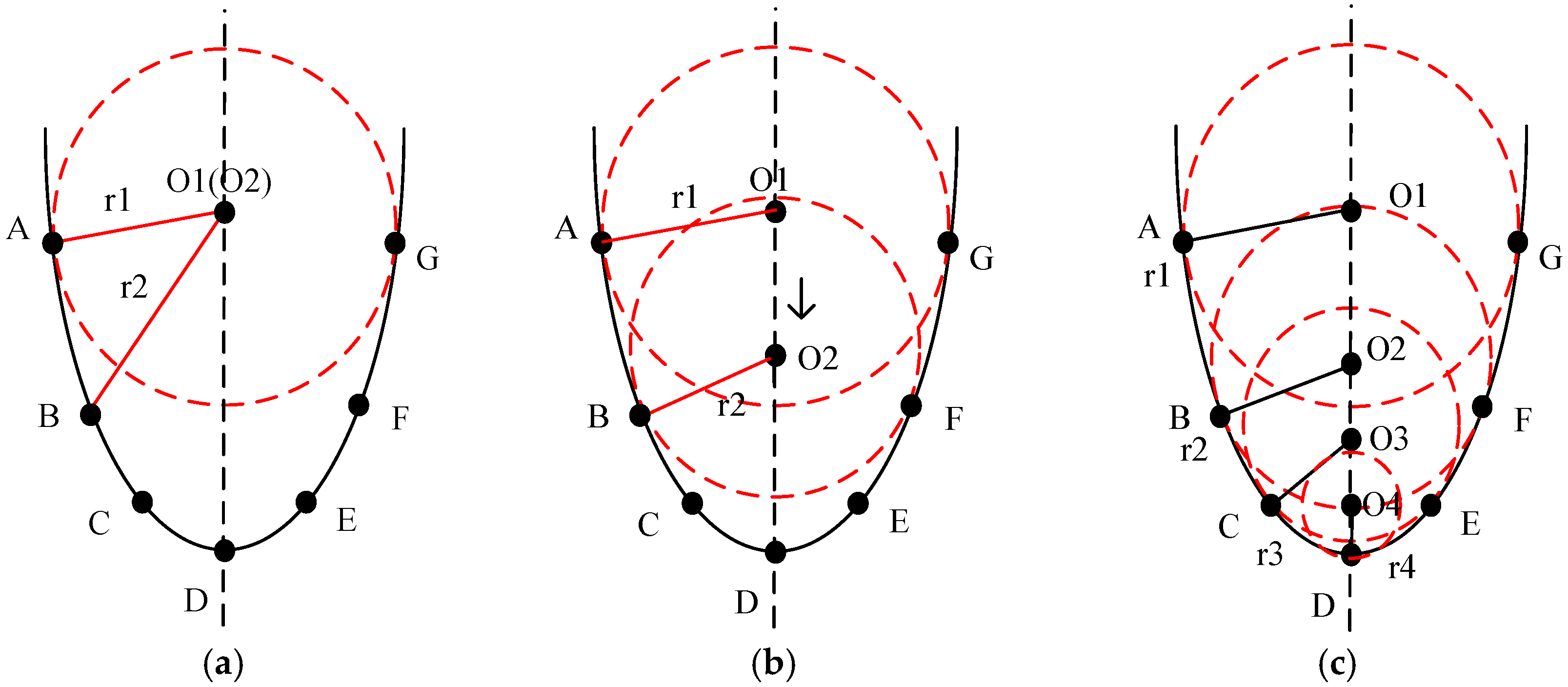
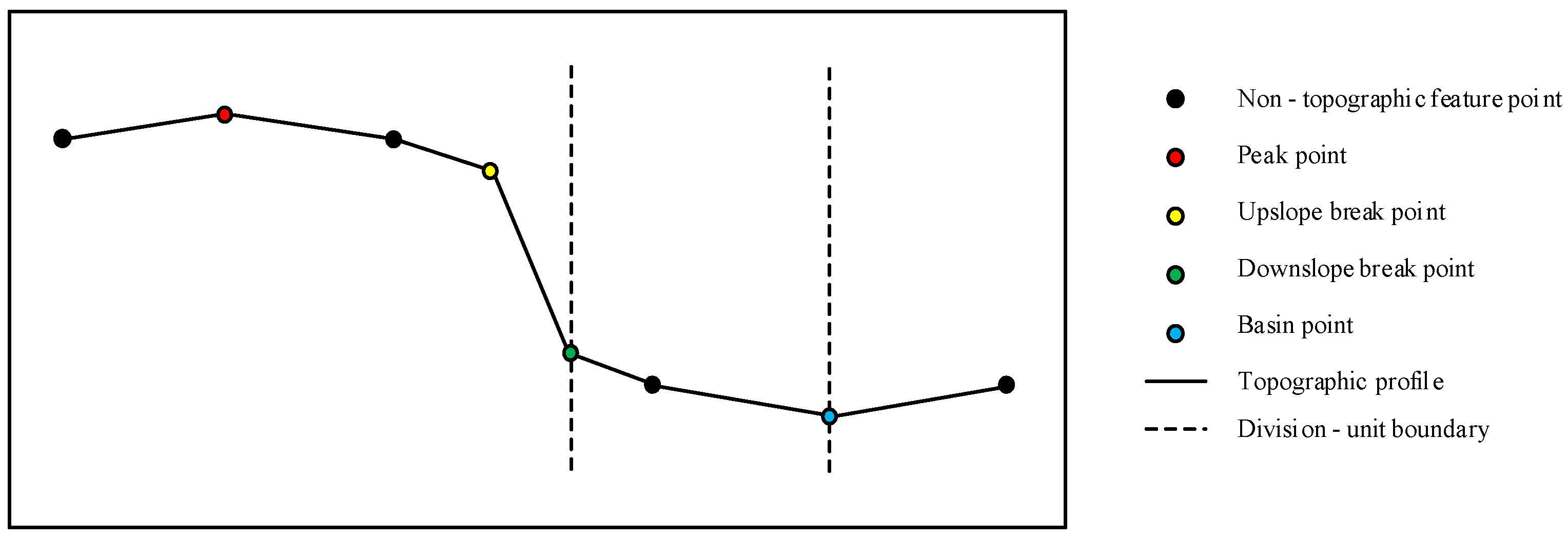
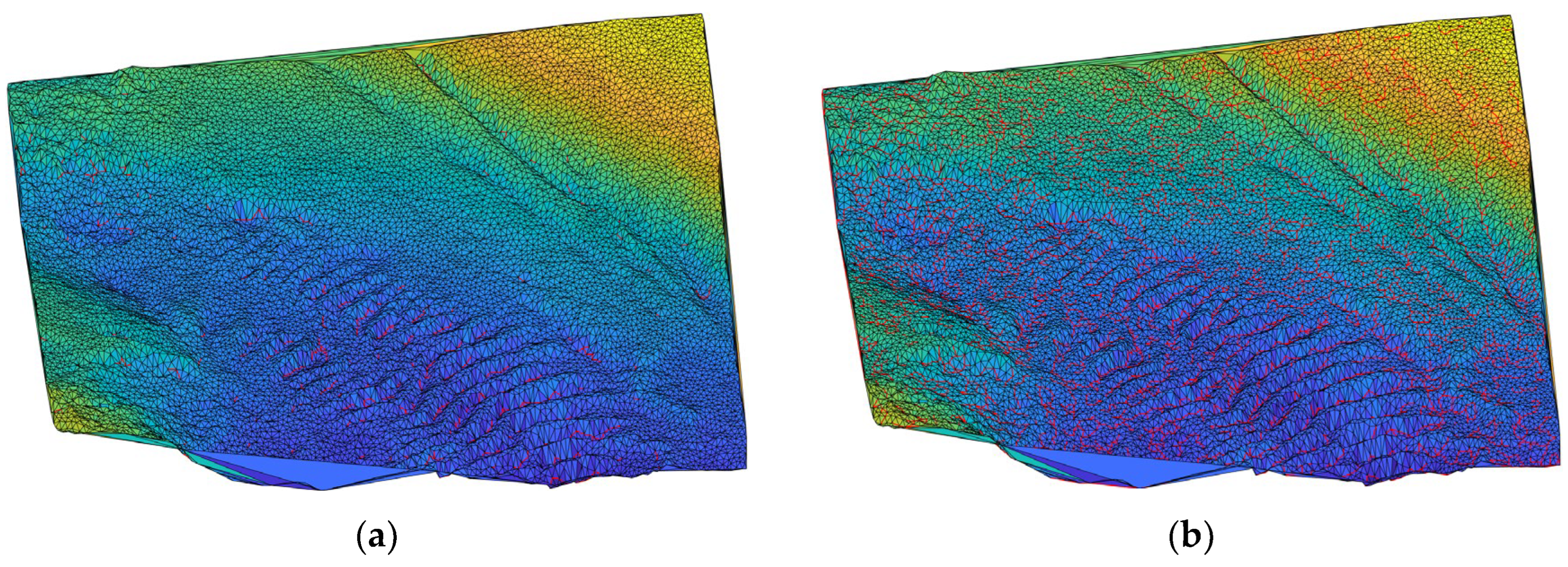
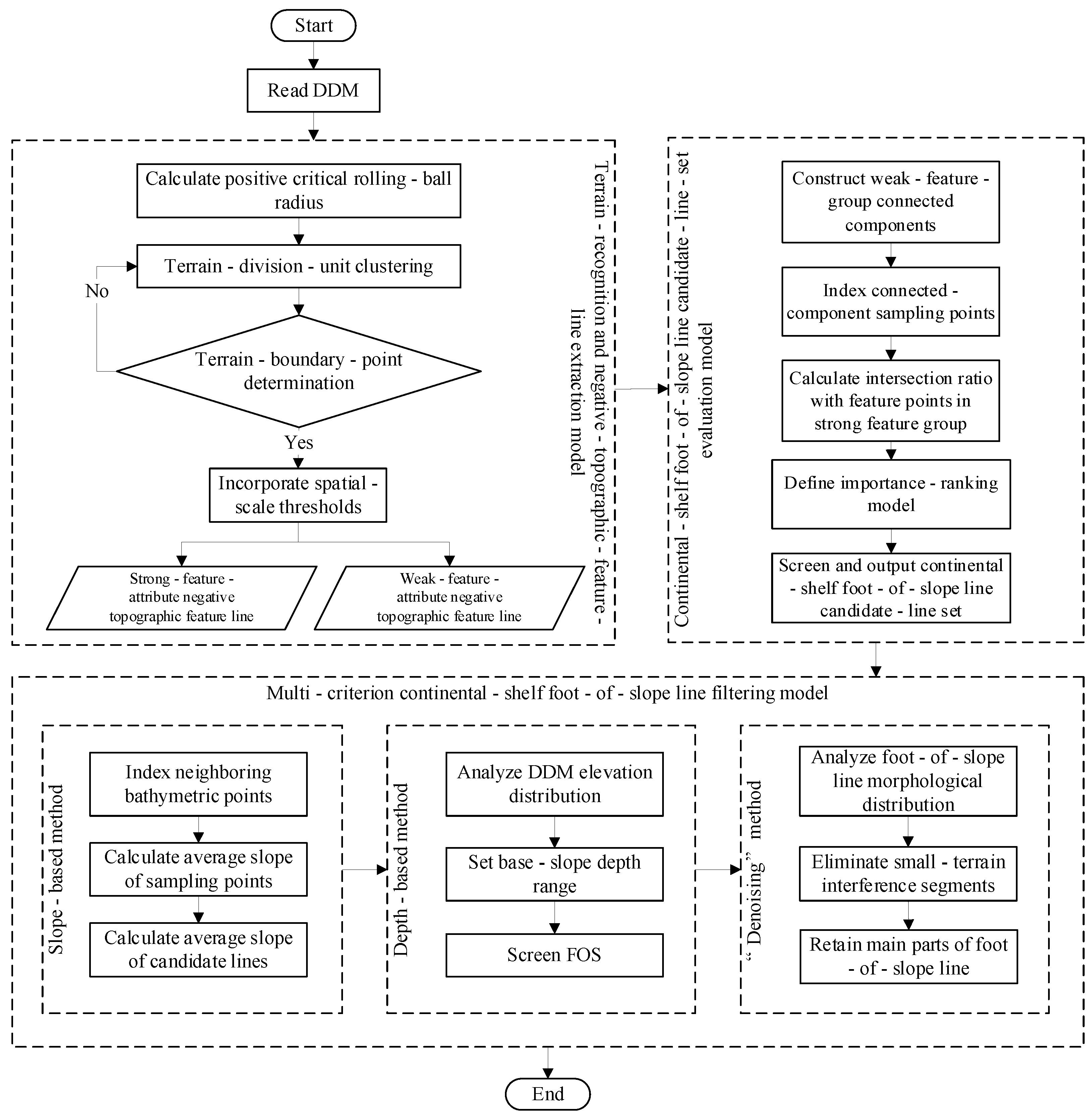
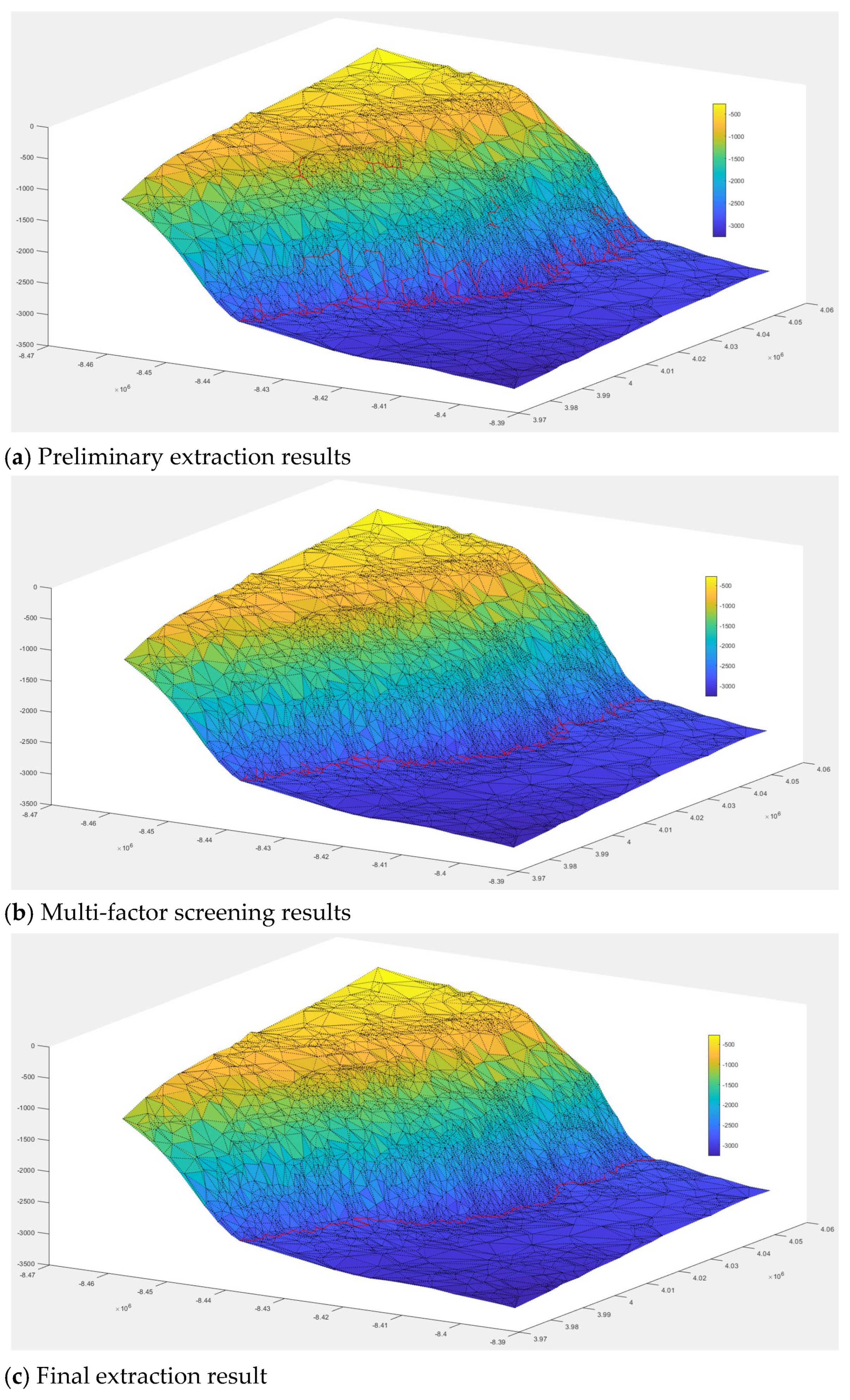

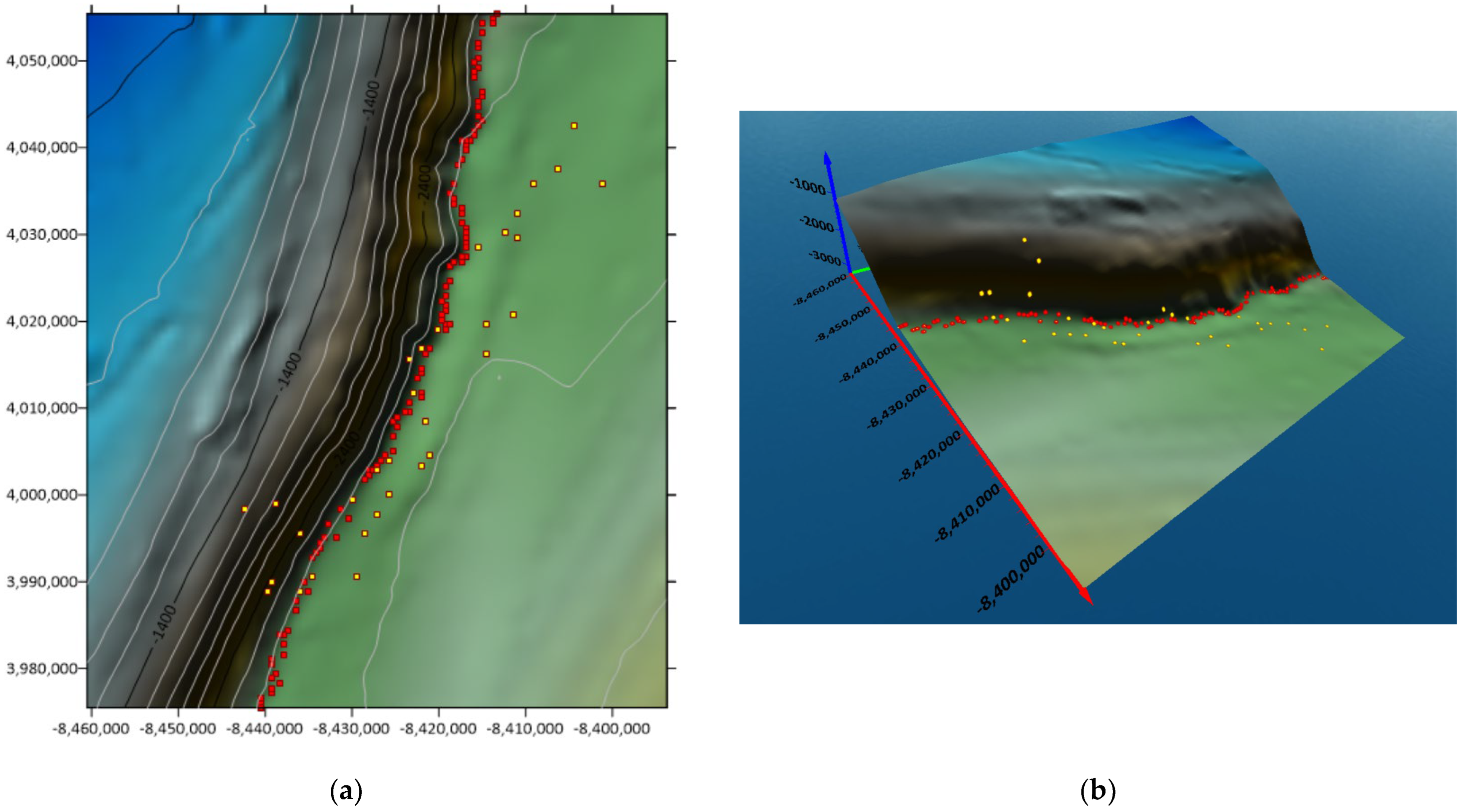
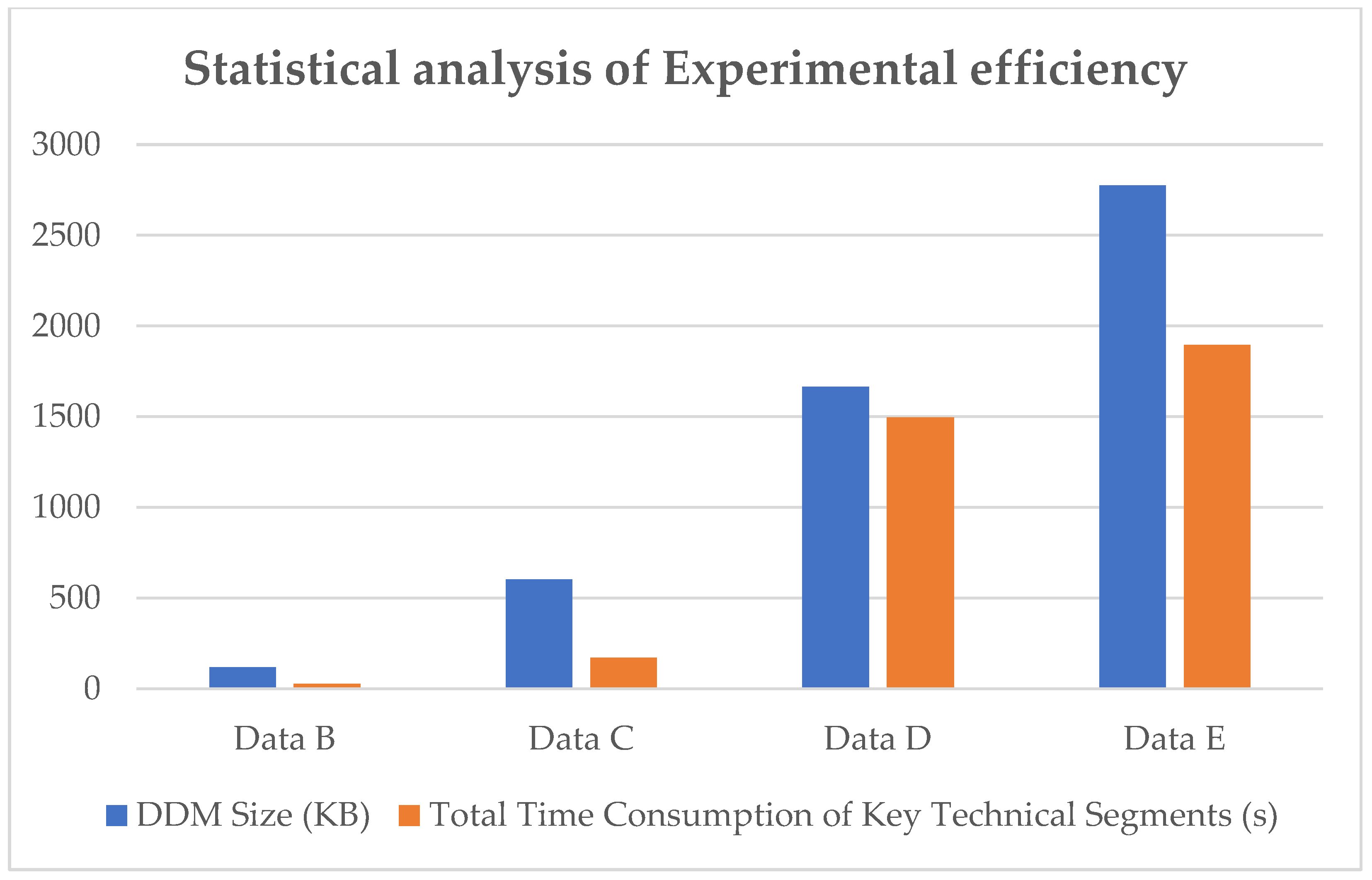
| Screening Result | |
|---|---|
| r = 0.0 |  |
| r = 0.5 | 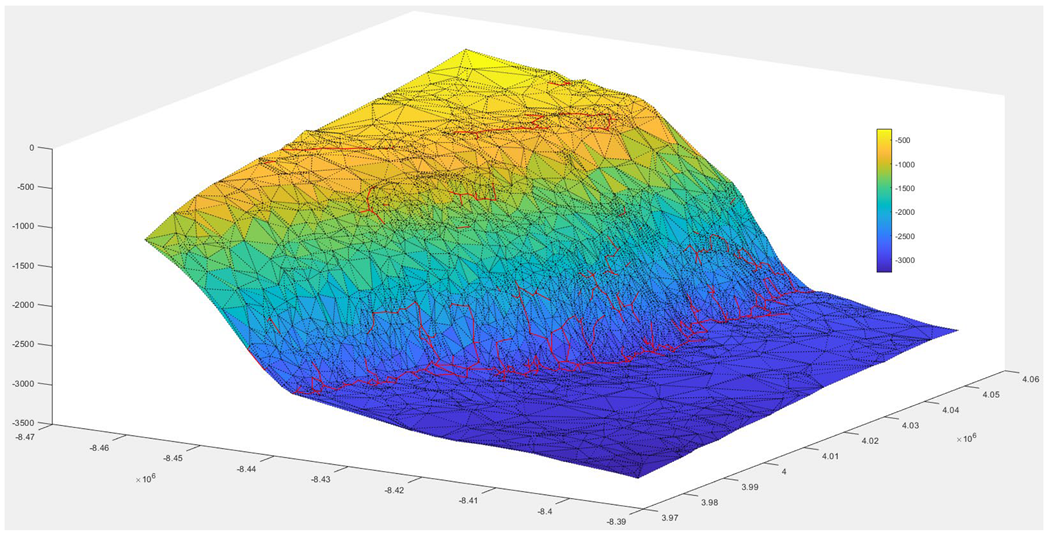 |
| r = 0.72 | 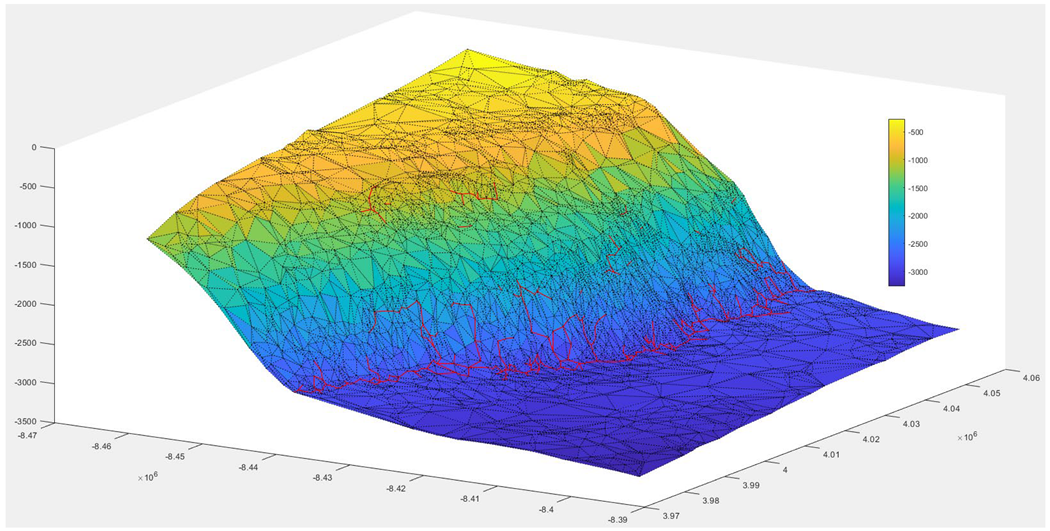 |
| r = 0.8 |  |
| Method | Method I | Method II | |||
|---|---|---|---|---|---|
| Technical Segment | Rolling Ball Transformation for Generating Buffer Surface | Extracting Negative Topographic Feature Lines | Extracting Continental Margin FOS Line Segments | Multi-Criteria Continental Margin FOS Line Filtering Process | Operator Process |
| Segment Timing (s) | 2.085 + 2.073 | 0.278 × 10 | 0.144 × 6 | 726.8 | 1994.6 |
| Total Process Time (s) | 734.6 | 1994.6 | |||
| Continental Margin Terrain Data | Data B | Data C | Data D | Data E | |
|---|---|---|---|---|---|
| DDM Size (KB) | 119 | 603 | 1664 | 2775 | |
| Quantity of Bathymetric Points | 3600 | 20,736 | 57,601 | 100,890 | |
| Rolling Ball Buffer Surface Generation Time (s) | Upper Buffer Surface | 1.452 | 59.564 | 638.511 | 379.513 |
| Lower Buffer Surface | 23.028 | 57.685 | 167.304 | 920.106 | |
| Negative Topographic Feature Line Extraction Time (s) | 0.209 × 10 | 3.977 × 10 | 34.812 × 10 | 56.744 × 10 | |
| Continental Margin Foot-of-Slope Line Extraction Time (s) | 0.113 × 10 | 1.288 × 10 | 3.41 × 10 | 2.846 × 10 | |
| Total Time Consumption of Key Technical steps (s) | 27.700 | 169.899 | 1494.935 | 1895.519 | |
Disclaimer/Publisher’s Note: The statements, opinions and data contained in all publications are solely those of the individual author(s) and contributor(s) and not of MDPI and/or the editor(s). MDPI and/or the editor(s) disclaim responsibility for any injury to people or property resulting from any ideas, methods, instructions or products referred to in the content. |
© 2025 by the authors. Licensee MDPI, Basel, Switzerland. This article is an open access article distributed under the terms and conditions of the Creative Commons Attribution (CC BY) license (https://creativecommons.org/licenses/by/4.0/).
Share and Cite
Wang, D.; Dong, J.; Zhang, Z.; Xie, T.; Ma, X.; Wang, T. Accurate Extraction Method for Continental Margin FOS Line Considering Terrain Continuity. J. Mar. Sci. Eng. 2025, 13, 1744. https://doi.org/10.3390/jmse13091744
Wang D, Dong J, Zhang Z, Xie T, Ma X, Wang T. Accurate Extraction Method for Continental Margin FOS Line Considering Terrain Continuity. Journal of Marine Science and Engineering. 2025; 13(9):1744. https://doi.org/10.3390/jmse13091744
Chicago/Turabian StyleWang, Dong, Jian Dong, Zhiqiang Zhang, Tian Xie, Xiaodong Ma, and Tianyue Wang. 2025. "Accurate Extraction Method for Continental Margin FOS Line Considering Terrain Continuity" Journal of Marine Science and Engineering 13, no. 9: 1744. https://doi.org/10.3390/jmse13091744
APA StyleWang, D., Dong, J., Zhang, Z., Xie, T., Ma, X., & Wang, T. (2025). Accurate Extraction Method for Continental Margin FOS Line Considering Terrain Continuity. Journal of Marine Science and Engineering, 13(9), 1744. https://doi.org/10.3390/jmse13091744





